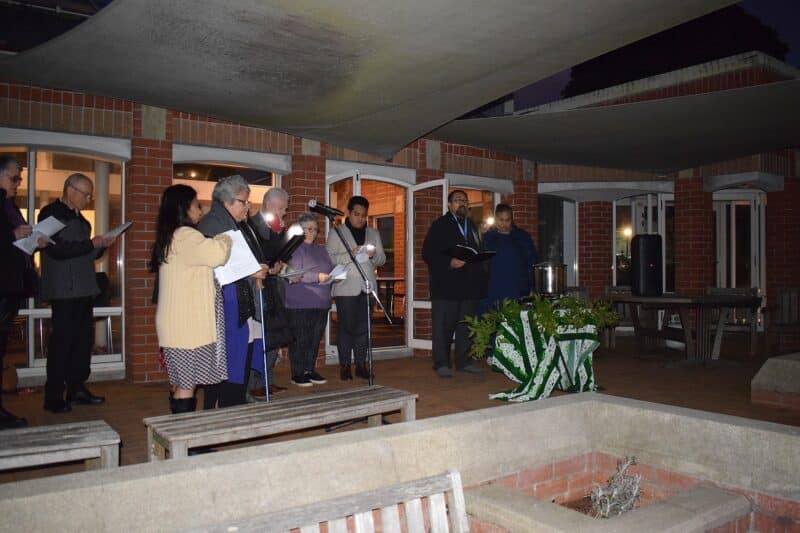The Catholic Diocese of Auckland marked the time of Matariki – the Maori New Year – with prayers and kai at the Pompallier Diocesan Centre on July 13.
Led by Auckland diocese vicar for Maori Manuel Beazley, staff and visitors gathered outdoors just before dawn, with many giving quiet thanks that the weather in Tamaki Makaurau-Auckland, was, for once, clement.
The ceremony started with an invitation to call to mind and to name out loud, those who had died in the past year.
Then aspects of God’s creation – soil, birds, fresh water and its creatures, salt water, rain, wind and Hiwa-i-te-rangi, connected to the Matariki (Pleiades) star cluster – were named, and those present prayed that the Holy Spirit might kindle in the hearts of God’s faithful the fire of his love, and that the Spirit might renew the face of the earth.
A passage from Revelation 4 was read, recalling the heavenly cry of “Holy, holy, holy is the Lord God Almighty, who was and who is to come”. The reading also made reference to the creatures giving “glory and honour and thanks to him who is seated on the throne, [and] they worshipped him, saying, ‘worthy are you, our Lord and God, to receive glory and honour and power for you created all things, and by your will they existed and were created’”.
Mr Beazley told those at the ceremony that, “in order to locate Matariki, we look to the rising sun. And in order to locate our own Christian lives, we look to the risen Son of God”.
“As we come to this Matariki, this time of remembering the past with gratitude, celebrating the present, and looking forward with great hope to the wonderful things ahead, let us celebrate this Matariki, this uniquely Aotearoa festival,” he said.
Those at the ceremony then went indoors and enjoyed a hearty breakfast.
This ceremony was an example of the inculturation of the Gospel of Jesus Christ in Aotearoa New Zealand.
As St John Paul II said during his 1986 visit to Aotearoa New Zealand, “As you rightly treasure your culture, let the Gospel of Christ penetrate and permeate it, confirming your sense of identity as a unique part of God’s household. It is as Māori that the Lord calls you, it is as Māori that you belong to the Church, the one Body of Christ.”
In 1975, St Paul VI, in his apostolic exhortation Evangelii Nuntiandi, wrote: “The kingdom which the Gospel proclaims is lived by men who are profoundly linked to a culture, and the building up of the kingdom cannot avoid borrowing the elements of human culture or cultures. Though independent of cultures, the Gospel and evangelisation are not necessarily incompatible with them; rather they are capable of permeating them all without becoming subject to any one of them.” (EN20).
The fathers of the Second Vatican Council, in their document Nostra Aetate, had made a similar statement regarding the religious aspects arising from these cultures: “. . . other religions found everywhere try to counter the restlessness of the human heart, each in its own manner, by proposing ‘ways’, comprising teachings, rules of life, and sacred rites. The Catholic Church rejects nothing that is true and holy in these religions. She regards with sincere reverence those ways of conduct and of life, those precepts and teachings which, though differing in many aspects from the ones she holds and sets forth, nonetheless often reflect a ray of that Truth which enlightens all men. Indeed, she proclaims, and ever must proclaim Christ ‘the way, the truth, and the life’ (John 14:6), in whom men may find the fullness of religious life, in whom God has reconciled all things to himself”.
In a 2006 message to participants in the Culture Summit in Asia, Pope Benedict XVI seemingly went further than what Paul VI had written, and stated that “evangelisation and inculturation constitute an inseparable pair, both elements of which must be present if the Gospel of Christ is truly to become incarnate in the lives of people of every race, nation, tribe and language”.
In 1988, the International Theological Commission released “Faith and Inculturation”, which asked – How may one harmonise the spontaneous expressions of the religiosity of peoples with faith?
The document called for a great respect for all that is “true and holy in the cultural heritage of a people”.
But at the same time, “this attitude does not demand that one should lend an absolute character to this cultural heritage”.
Speaking from a perspective that is both Maori and Christian, Laidlaw College Maori director Bradford Haami posed the question – can the Church in New Zealand celebrate Matariki?
“I think we can,” Mr Haami said in a video released just before Matariki this year, “But with a different emphasis.”
Having noted that “the stars are there to glorify God, not to be glorified, or to be given homage, or to be worshipped. We are called to praise God, the creator of the stars, not to praise creation”, Mr Haami added that “We have also woken up at dawn, gone outside and located Matariki, and the other stars, glorified God, creator of the stars with praise, broken bread together, and contemplated the present days to come”.
“All of us can do this,” he said. “We can gather together, we can share a kai together, we can praise the creator of the heavens and the stars together.”
“Why don’t we let the stars point us to the King of Kings?”
Photo: Auckland diocese vicar for Maori Manuel Beazley leads the Matariki ceremony at the Pompallier Diocesan Centre

Reader Interactions